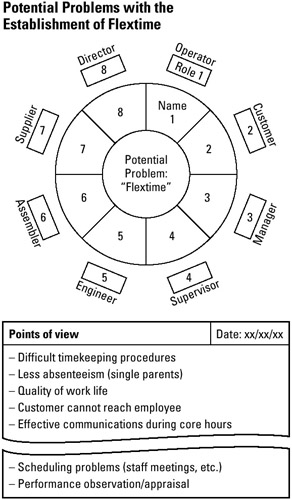Tool 169: Rotating Roles
| AKA | Rotating Chairs, Perspective Wheel |
| Classification | Changing/Implementing (CI) |
Tool description
The rotating roles activity is a very effective tool for expanding a team's perspectives on the possible consequences or problems resulting from organizational change or from implementation efforts for process, product, or service improvements. Rotating between roles allows participants to bring forward different views in that role or position as a process owner or stakeholder, views that often do not surface unless you "act out" a particular role.
Typical application
-
To collect more perspectives or views on the problem at hand.
-
To identify the concerns, issues, or opportunities for a team's consideration before taking action.
-
To see different possibilities by "acting out" a particular process owner's role or position in the organization.
Problem-solving phase
| Select and define problem or opportunity | |
| → | Identify and analyze causes or potential change |
| → | Develop and plan possible solutions or change |
| Implement and evaluate solution or change | |
| Measure and report solution or change results | |
| Recognize and reward team efforts |
Typically used by
| Research/statistics | |
| 2 | Creativity/innovation |
| Engineering | |
| 3 | Project management |
| Manufacturing | |
| Marketing/sales | |
| 4 | Administration/documentation |
| Servicing/support | |
| Customer/quality metrics | |
| 1 | Change management |
before
-
Different Point of View
-
Circles of Influence
-
Fishbowls
-
Customer Acquisition-Defection Matrix
-
Interview Technique
after
-
Presentation
-
Critical Dialogue
-
Team meeting evaluation
-
Starbursting
-
What-If-Analysis
Notes and key points
-
Works best with 5–8 participants.
-
Have one prepared flip chart for each role.
-
Rotate one space at a time until all participants have had each role.
-
No "pass" is permitted!
Step-by-step procedure
-
STEP 1 The facilitator prepares a wheel with participants' names and writes the problem in the center of the wheel. Role cards and a flip chart for each role must also be prepared. See example Potential Problems with the Establishment of Flextime.
-
STEP 2 Participants are seated around the table and the facilitator explains the purpose and rules of the activity.
-
STEP 3 Every participant views the problem from his/her present role and records concerns, insights, ideas, or recommendations on the appropriate flip chart prepared for this role. After everyone has finished, the wheel is rotated one position or, as an option, participants move to the next chair.
-
STEP 4 This process of rotation continues, and ideas are recorded on the flip charts, until all participants have rotated through all roles. No "pass" is allowed.
-
STEP 5 The facilitator ends the session and compiles flip chart information for the team's next step in the problem solving or quality improvement effort as shown in the example.
Example of tool application

EAN: 2147483647
Pages: 326